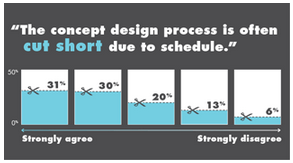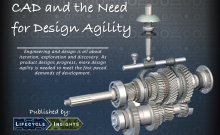 Concept design is crucial to product development. It doesn’t matter whether you use traditional techniques, 2D tools, or 3D tools, getting your concept design right is vital for the subsequent stages of product development. This is where creative and innovative ideas can have the most impact; before a product have been involved in weeks of design development.
Concept design is crucial to product development. It doesn’t matter whether you use traditional techniques, 2D tools, or 3D tools, getting your concept design right is vital for the subsequent stages of product development. This is where creative and innovative ideas can have the most impact; before a product have been involved in weeks of design development.
What is the current state of concept design?
A recent survey conducted by PTC [Source:PTC], uncovered significant opportunities for efficiency gains and process improvements during this important phase of the product lifecycle. Respondents to the survey agreed that if you don’t start with a good concept then your product is going to fail. This all leads to loss of valuable market share, dissatisfied customers, wasted resources, and wasted time.
Another finding of this survey was that this important stage is often cut short due to timing pressures and the schedule. 61% of respondents to the survey agreed or strongly agreed that this was the case for them. Yet, a full 92% of customers agreed that they would benefit immensely by exploring more design options and alternatives during the concept design stage. It seems, therefore, that companies need to find a way to make it quicker and easier to explore a range of design alternatives, without having to spend more time on the concept design stage.
Alongside this, many respondents to the survey indicated that they needed to spend time recreating design data during the concept design stage because their design tool formats are not compatible. This causes them to lose time when they need it most.
How can you make the most of your concept design stage?
Concept design is the foundation of every project. It doesn’t matter whether you are starting with a clean sheet of paper or using and developing an existing concept, the ability to build upon these initial ideas and turn them into a final product is essential. It is only by having the space and the tools that support design exploration at this formative stage that companies are able to create products that solve their customer’s problems.
With the need to explore design alternatives often squeezed by time pressures, there needs to be a way to make time savings without limiting the quality of work. Advances made with the release of Creo 2.0 make this possible. For instance, Creo supports imports from common data formats, including Photoshop and Creo Sketch. After importing, these images can be scaled and then used as a reference point to develop a 3D model. By using Creo, you can access all the tools you need to create your concept designs, while having more time to explore design alternatives.
To find out more about using Creo in your design process, download our free eBook:
